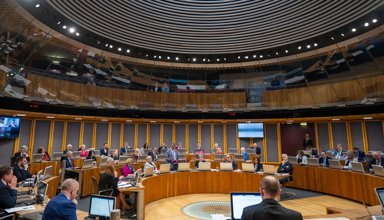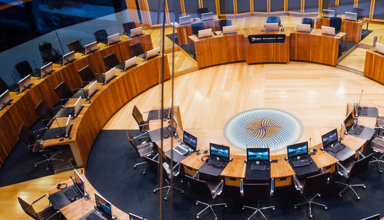Senedd election 2026
↓ When will the 2026 Senedd election be held?
↓ How do I stand for election in 2026?
↓ When was the last Senedd election?
↓ How many people voted in the last Senedd election?
Changes to the Senedd
↓ How is the Senedd (Welsh Parliament) changing in 2026?
↓ Will my constituency be changing?
↓ Will there be gender quotas at the 2026 election?
↓ Will there be a system for recalling Senedd Members?
Voting information
↓ Will the voting system be different at the next Senedd election?
↓ How will I know who I’m voting for?
↓ Can I still vote for an independent candidate?
Members of the Senedd
↓ How many Senedd Members will there be?
↓ Why does the Senedd need more Members?
↓ How many Members will be elected in my constituency?
Timeline and decision-making
↓ When will the changes to the Senedd happen?
↓ Who voted to make these changes?
↓ Why wasn't there a referendum on changes to the Senedd?
↓ How have people in Wales been consulted about the changes?
↓ How can I give you my views?
Senedd building and logistics
↓ Will the design of the Senedd need to alter to accommodate additional Members?
↓ Where will the Senedd sit while renovations are ongoing?
↓ How much will the changes cost?
After the election
↓ Will the Welsh Parliament meet more often?
↓ How many Welsh Ministers will there be?
↓ How many Presiding Officers will the Senedd have?
↓ Will Senedd elections happen more often?
Frequently Asked Questions
Senedd election 2026
When will the 2026 Senedd election be held?
The next Senedd election will be held on 7 May 2026.
How do I stand for election in 2026?
The Electoral Commission oversees all elections in the UK, including arrangements for the Senedd election in 2026. You can find information about standing as a candidate on their website.
When was the last Senedd election?
The last Senedd election was held on Thursday 6 May 2021.
Explore previous Senedd election results, including by-elections.
How many people voted in the last Senedd election?
Over 1.1 million voted in the last Senedd election on 6 May 2021. Based on valid votes, the turnout was 46.6%. (‘Valid votes’ means ballot papers that have not been spoilt or disallowed).
Senedd Research has produced an article which gives more information about turnout at previous Senedd elections and how this compares to UK general elections.
Changes to the Senedd
How is the Senedd (Welsh Parliament) changing in 2026?
Starting with the election on 7 May 2026, the Senedd is changing. These changes include:
- 96 Members: From 2026, the Senedd will have 96 Members.
- A new voting system: Members of the Senedd will be elected through a closed proportional list system, where voters choose either a political party or an independent candidate. The full list of candidates will appear on the ballot paper, so you can still see who you are voting for.
- New constituencies: Wales will have 16 constituencies for the next Senedd election. These will be created by pairing the 32 UK Parliament constituencies for Wales. Each new constituency will elect six Members. The new constituencies will be published in spring 2025.
- New rules: Anyone standing for election in Wales must live in Wales.
- More frequent elections: Senedd elections will take place every four years, starting from 2026.
What is Senedd reform?
“Senedd reform” refers to changes being made to the Senedd to prepare it for the future.
Will my constituency be changing?
Yes. Wales will have 16 constituencies instead of 40.
The Democracy and Boundary Commission Cymru created the new areas by pairing the 32 UK Parliament constituencies for Wales. They also considered local boundaries, road and transport links, and natural features like rivers and mountains.
For further information and maps of the new constituency areas, see our Senedd Research article:
New constituencies for the 2026 Senedd election announced
You can find your new constituency by entering your postcode into our constituency finder map.
Will there be gender quotas at the 2026 election?
No. The Welsh Government withdrew the Senedd Cymru (Electoral Candidate Lists) Bill in September 2024, which would have introduced a requirement for candidate quotas for women at Senedd elections. This would have meant setting a required minimum number or percentage of women who must be included as candidates in elections.
Instead, the Welsh Government has issued new guidance aimed at helping political parties improve diversity and inclusion among potential candidates hoping to stand in the 2026 Senedd election.
Will there be a system for recalling Senedd Members?
“Recalling” is a mechanism that allows voters to remove elected politicians between elections.
The Welsh Government introduced the Senedd Cymru (Member Accountability and Elections) Bill in November 2025. It is currently being considered by the Senedd.
The Bill aims to improve accountability of Members, by introducing a formal recall mechanism. This will allow constituents to remove Members via a poll if they receive a custodial sentence of a year or less, including suspended sentences, or if the Senedd votes to initiate a recall poll following a report of the Standards of Conduct Committee about a Member’s conduct. (Existing legislation means that any Member who receives a sentence of more than one year is automatically disqualified).
If passed, the Bill would also strengthen the Senedd’s standards process by:
- establishing a mandatory Standards of Conduct Committee.
- enabling the appointment of independent lay members to the Committee to bring in outside expertise.
- allowing the Standards Commissioner to open investigations about a Member’s conduct without needing a complaint to be made.
- placing a duty on Welsh Ministers to create a criminal offence of making or publishing false statements of fact during election campaigns. This is in response to the recommendations of the Standards of Conduct Committee report into deliberate deception.
Voting information
How do I register to vote?
Registering to vote is quick and easy.
You’ll be asked for your National Insurance Number, but you can still register if you don’t have one.
Who is eligible to vote?
To vote in the Senedd election on 7 May 2026 you must:
- be 16 years of age or over on the day of the election (polling day)
- be registered to vote
- be a British, Irish or qualifying Commonwealth citizen, a citizen of the European Union, or a qualifying foreign citizen
- live in Wales, and
- be legally allowed to vote
Not sure if you’re eligible?
The Electoral Commission has lots more information about registering to vote on their website:
Register to vote | Electoral Commission
Will the voting system be different at the next Senedd election?
Yes. At the 2026 Senedd election, anyone over the age of 16 will now have one vote to choose representatives for their community in the Senedd.
Members of the Senedd will be elected through a closed proportional list system, where voters choose either a political party or an independent candidate.
The ballot paper will show the full list of candidates in your constituency, so you can still see who you're voting for.
If a party or independent candidate wins enough votes in your area, they will win one or more seats in the Senedd. Seats will be allocated based on the percentage of votes each party or independent candidate receives, using a method called the D’Hondt formula.
How will I know who I’m voting for?
Your ballot paper will list the names of the candidates standing for each political party, alongside any independent candidates. You will vote for a party or an independent candidate.
Can I still vote for an independent candidate?
Yes. Independent candidates standing for election in your constituency will be listed on your ballot paper.
Members of the Senedd
How many Members of the Senedd will there be?
At the 2026 Senedd election 96 Members will be elected, compared to 60 at previous elections.
Why does the Senedd need more Members?
The Senedd has had the same number of Members for 25 years, despite an increase in its powers.
The Senedd now possesses full law-making powers and the ability to raise taxes in Wales, which it could not do when it was created in 1999.
More Members will give the Senedd greater ability to look at and challenge the Welsh Government’s plans and spending on major issues like the health service, education and transport, giving your community a stronger voice when these decisions are made.
The changes will strengthen and prepare the Senedd for the future.
The Senedd is the smallest parliament in the UK and one of the smallest in Europe. Increasing the number of Members to 96 will bring it more in line with other countries of a similar size to Wales, like Scotland which has 129 Members and Northern Ireland which has 90.
There has been a lot of research into whether the Senedd has enough Members.
In 2011, there was a public vote (referendum) on whether the then Assembly should have more law-making powers. A total of 63.5% of voters were in favour of the change.
In 2015, the Assembly Commission published a report looking at the future of the National Assembly for Wales. It unanimously called for more Members, stating the Assembly was “underpowered and overstretched”.
Previous research conducted by the Expert Panel on Assembly Electoral Reform, the Committee on Senedd Electoral Reform and the Special Purpose Committee on Senedd Reform, all recognised the need for change and growth.
How many Members will be elected in my constituency?
Six Members will be elected in each of the new constituencies. This means that wherever you live in Wales, six Members will represent you and your community in the Senedd. You can contact any or all of them about issues in your local area.
Timeline and decision-making
When will the changes to the Senedd happen?
The new voting system and constituency boundaries will begin at the 2026 Senedd election, when 96 Members will be elected.
Who voted to make these changes?
On 8 May 2024, a supermajority of Members was needed to vote in favour of the changes to the Senedd. Members voted 43 to 16 to pass the Senedd Cymru (Members and Elections) Bill.
The Bill then received Royal Assent from the King, becoming an Act and law in Wales in June 2024.
Why wasn't there a referendum on changes to the Senedd?
The changes to the Senedd were introduced in a Bill by the Welsh Government. Confirmation through a referendum was not included in the proposal, which was based on years of research, public consultation, and scrutiny. Proposed amendments at the Bill’s Stage 2 and 3 proceedings which would have added a requirement for a referendum were unsuccessful.
Under the Wales Act 2017, the Senedd gained powers to legislate on its own size and electoral arrangements as long as changes are supported by at least two thirds of Members. A supermajority of 43 out of 60 Members voted in favour of the changes in 2024, and the law to bring them about was passed.
How have people in Wales been consulted about the changes?
The changes to the Senedd have undergone multiple public consultations:
- In 2011, there was a public vote (referendum) on whether the then Assembly should have more law-making powers. A total of 63.5% of voters were in favour of the change.
- In 2018 by the Senedd Commission: Creating a Parliament for Wales: full consultation report.
- In 2023, by the Senedd’s Reform Bill Committee. You can read all the responses to the consultation and the Committee’s report on the Senedd website.
- In 2024, the Democracy and Boundary Commission Cymru ran two public consultations on the proposed constituency changes. You can find out more on their website.
For further information about the history of reforms to the Senedd, please see the Research Service article: Senedd reform - the story so far.
How can I give you my views?
You can contact any of your current Members of the Senedd about the changes.
Senedd building and logistics
Will the design of the Senedd need to alter to accommodate additional Members?
The Senedd’s debating chamber, the Siambr, will be altered to accommodate all 96 Members. Work will start in April 2025 and be completed in spring 2026.
The original design of the Siambr, by architects Rogers Stirk Harbour + Partners (RSHP), allowed room for expansion if there was ever an increase in Members. Although this is still the case, work needs to be done to install things like desks and ICT equipment.
Where will the Senedd sit while renovations are ongoing?
Senedd Members will still attend Plenary while work to adapt the debating chamber is ongoing.
Members will meet for Plenary in Siambr Hywel. This is the original debating chamber in Tŷ Hywel where plenary meetings were first held before the Senedd building was opened.
Since then it has been used by the Commission’s Education team as a learning space for visiting schools.
How much will the changes cost?
This is the biggest change to the Senedd since it was established in 1999. The total costs of these changes are not yet known as they are dependent on things like how new Senedd Members will want the Senedd to operate after the 2026 election.
Throughout the process, the Senedd Commission aims to provide maximum benefits and value for money.
The Senedd Commission’s Budget 2025-26 proposes a 16% increase in spending to support a 60% increase in Members.
These estimates will be kept under constant review, and cost savings will be made wherever possible.
After the election
Will the Welsh Parliament meet more often?
One of the first decisions Members will make after the election is how to organise parliamentary business. They will need to plan time for both Plenary (when all Members meet in the debating chamber) and committee meetings.
The Future Senedd Committee was set up to help with this. It has already looked at different ways to organise Senedd business, such as adding a third day for Plenary or having a multi-week timetable, like some schools. A multi-week timetable could include, for example, week one focussing on plenary, the second a mixed week and the third focussing on committee work.
The Committee published a report giving its recommendations after looking at the pros and cons of each approach. However, the final decision will rest with the newly elected Members of the Senedd when they meet after the election.
How many Presiding Officers will the Senedd have?
The current Senedd has one Llywydd (Presiding Officer) and one Deputy Presiding Officer. After the 2026 election, Members can choose whether to elect a second Deputy Presiding Officer if they think the position is needed.
How many Welsh Ministers will there be?
After the 2026 election the First Minister can appoint a cabinet of up to 17 ministers and cabinet secretaries, or up to 19 with the Senedd’s approval. This does not include the First Minister and the Counsel General, the Welsh Government’s chief legal adviser.
Will Senedd elections happen more often?
Yes. Senedd elections will take place every four years, starting from 2026.





